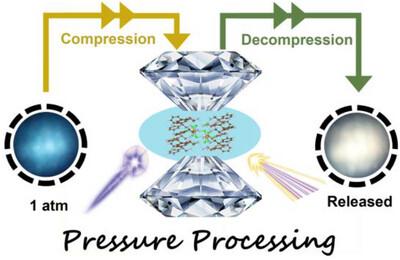Pressure-Induced Emission Luminogens from Antimony Chloride Dimers Toward White-Light Emission Harvesting
IF 10
1区 物理与天体物理
Q1 OPTICS
引用次数: 0
Abstract
The pressure-induced emission (PIE) properties of low-dimensional organic-inorganic hybrid perovskites (OIHPs) have attracted considerable interest due to their capacity of enhancing luminescent efficiency. Here, a high-pressure processing strategy is demonstrated to significantly improve the photoluminescent efficiency of the 0D OIHP [3-FPEA]6(Sb2Cl10)*2Cl. Notably, [3-FPEA]6(Sb2Cl10)*2Cl with blue emission at ambient conditions achieved a white-light emission after pressure treatment of 30.0 GPa. The white-light emission is mainly the result of the cooperative emission of the singlet state emission of organic molecules and the self-trapped excitons (STEs) emission related to inorganic octahedra. This irreversible emission transformation correlates with pressure-induced permanent structural amorphization and the pronounced steric hindrance imparted by the conformationally bulky 3-FPEA cations. Moreover, a marked piezochromism from blue emission to yellow emission in compressed [3-FPEA]6(Sb2Cl10)*2Cl is observed, which is associated with the energy transfer from organic components to inorganic components under pressure. Furthermore, the distortion of the inorganic octahedron and the weakening of hydrogen bond vibrations are the key factors contributing to the enhancement of the yellow light. This study provides a new perspective on the modulation of coordinated emission originated from organic and inorganic components in OIHPs materials and a new platform for the development of high-quality single-component white-light-emitting materials.

从二聚体中获得压力致发射发光物质的白光发射收获
低维有机-无机杂化钙钛矿(OIHPs)的压力致发光(PIE)特性由于其提高发光效率的能力而引起了人们的广泛关注。本文证明了高压处理策略可以显著提高0D OIHP [3-FPEA]6(Sb2Cl10)*2Cl的光致发光效率。值得注意的是,在环境条件下具有蓝光发射的[3-FPEA]6(Sb2Cl10)*2Cl经过30.0 GPa的压力处理后实现了白光发射。白光发射主要是有机分子的单线态发射和无机八面体的自俘获激子(STEs)发射协同发射的结果。这种不可逆的发射转变与压力诱导的永久结构非晶化和构象庞大的3-FPEA阳离子所带来的明显的位阻有关。此外,在压缩[3-FPEA]6(Sb2Cl10)*2Cl中观察到明显的从蓝色发射到黄色发射的压变色现象,这与压力下有机组分向无机组分的能量转移有关。此外,无机八面体的畸变和氢键振动的减弱是黄光增强的关键因素。该研究为OIHPs材料中有机和无机组分协同发光的调制提供了新的视角,为开发高质量的单组分白光材料提供了新的平台。
本文章由计算机程序翻译,如有差异,请以英文原文为准。
求助全文
约1分钟内获得全文
求助全文
来源期刊
CiteScore
14.20
自引率
5.50%
发文量
314
审稿时长
2 months
期刊介绍:
Laser & Photonics Reviews is a reputable journal that publishes high-quality Reviews, original Research Articles, and Perspectives in the field of photonics and optics. It covers both theoretical and experimental aspects, including recent groundbreaking research, specific advancements, and innovative applications.
As evidence of its impact and recognition, Laser & Photonics Reviews boasts a remarkable 2022 Impact Factor of 11.0, according to the Journal Citation Reports from Clarivate Analytics (2023). Moreover, it holds impressive rankings in the InCites Journal Citation Reports: in 2021, it was ranked 6th out of 101 in the field of Optics, 15th out of 161 in Applied Physics, and 12th out of 69 in Condensed Matter Physics.
The journal uses the ISSN numbers 1863-8880 for print and 1863-8899 for online publications.

 求助内容:
求助内容: 应助结果提醒方式:
应助结果提醒方式:


